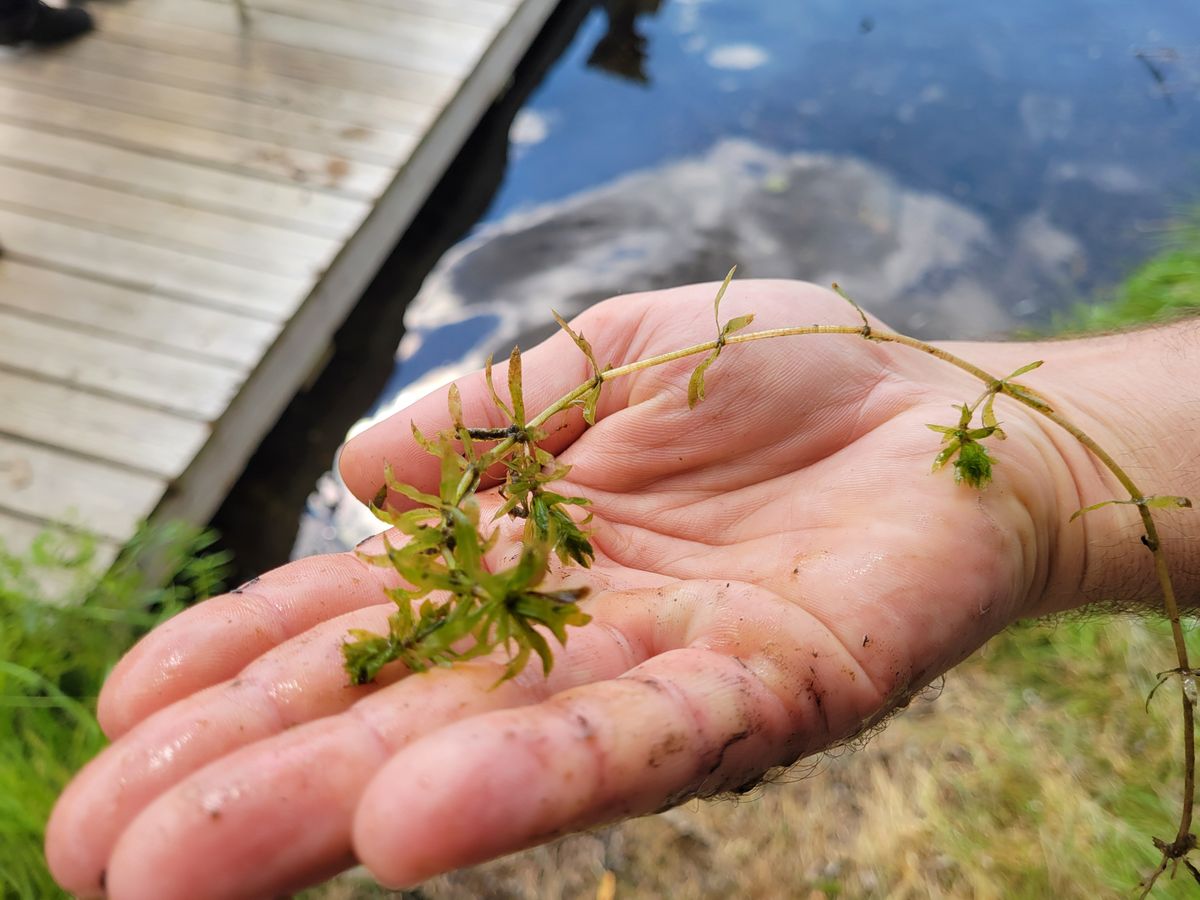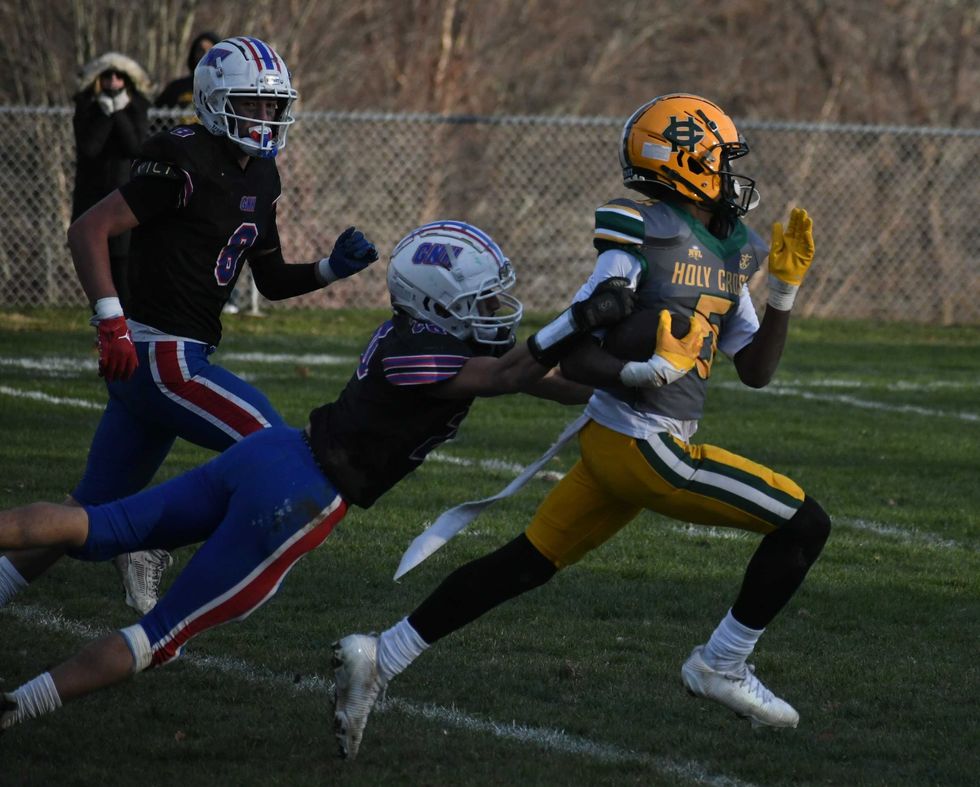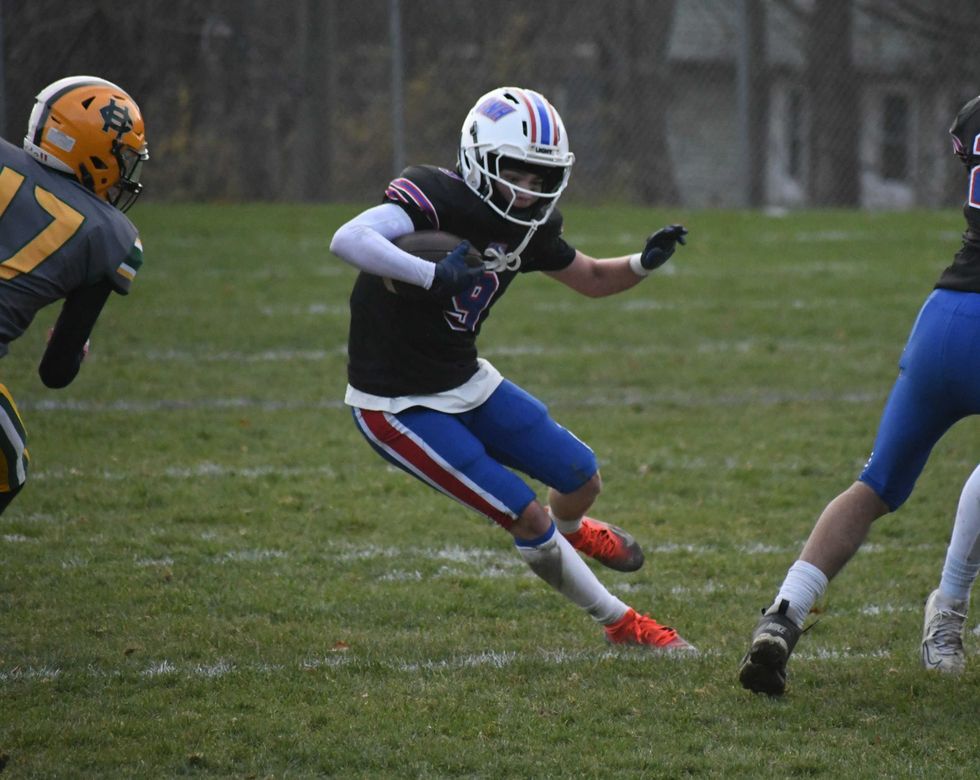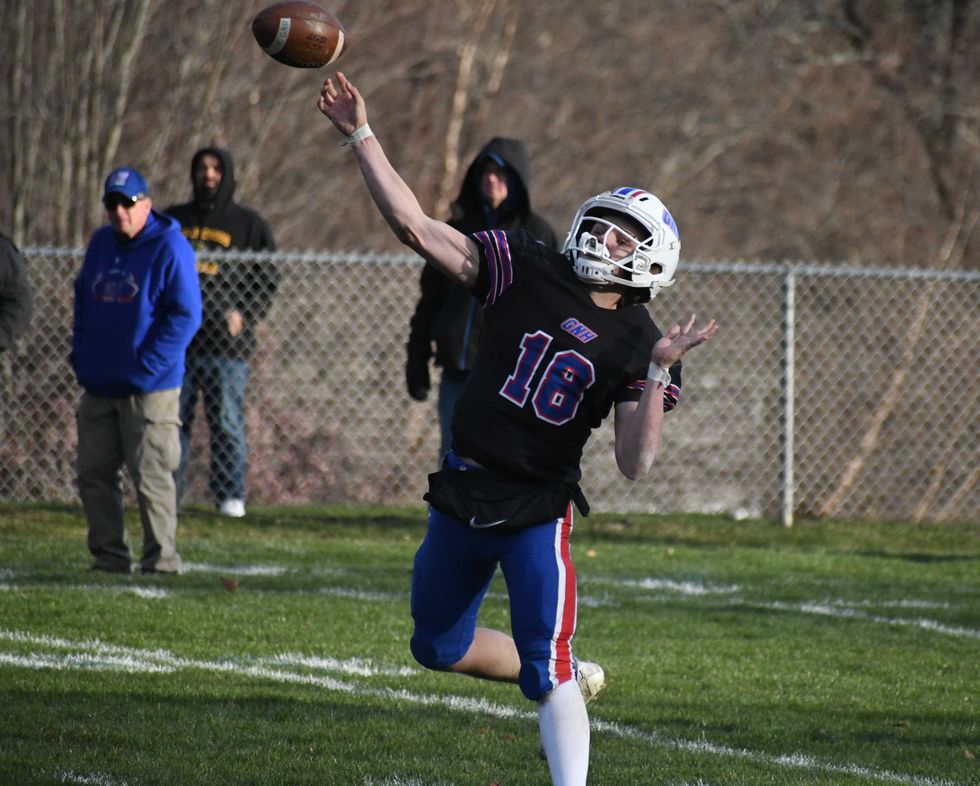The Hydrilla Menace: Twin Lakes group buoyed by DEEP’s assault on invasive hydrilla in 2025

A detail of a whorl of hydrilla pulled from the shallow waters at O’Hara’s Landing Marina in fall of 2024.
Photo by Debra A. Aleksinas

A detail of a whorl of hydrilla pulled from the shallow waters at O’Hara’s Landing Marina in fall of 2024.
SALISBURY — The Twin Lakes Association is taking an earlier and more aggressive approach to fighting the spread of invasive hydrilla in East Twin Lake by dosing the whole northeast bay, from May through October, with low-level herbicide treatments instead of spot treatments.
The goal, said Russ Conklin, the TLA’s vice president of lake management, is to sustain herbicide concentration over the 2025 growing season.
That plan of attack will continue over a period of 60 to 90 days beginning May 21, Conklin explained during the association’s April 30 membership meeting via Zoom which drew 60 attendees.
TLA officials were encouraged by the chance to stop the spread and hopefully destroy the thick mats of the unyielding invasive plant hydrilla verticillata, referred to as the Connecticut River variant, after two years of chasing new growth around the lake’s north bay.
Dense patches were first discovered in the summer of 2023 in shallow waters around O’Hara’s Landing Marina and the nearby state boat launch and the plant has since migrated further into East Twin, following a pattern of boat traffic.
Past treatment efforts were hampered by delayed permits from the state Department of Energy and Environmental Protection to treat the hydrilla with herbicides in an area where a rare plant had been identified.
This year, the TLA was granted an exception by DEEP, said Conklin, as any protected plant species in the path of hydrilla would likely not survive anyway.
“It is not dead now, but it is going to be if we don’t do something about the hydrilla.”
“This is a big year for us,” Conklin said. “Hydrilla is a real threat to the lake, and we did treat it this past year, but the permits only applied to the plant, so we spot treated it … and were always chasing it.”
The course of action this year, he said, is to treat the entire northeast bay with the herbicide Sonar in both liquid and crystal form at a very low levels so that the herbicide’s contact time with hydrilla will be extended for a longer period over 60 to 90 days.
“We know from past experience that it is much easier to kill the plant when it’s small,” Conklin explained. The goal, he said, is to attack the stringy, green weed before August when it crowns and splits into numerous growing points that are capable of growing at the rate of an inch a day.
During the hour-long meeting, discussion also focused on a pilot program for enhanced cyanobacteria monitoring at Twin Lakes to be headed by TLA director Jessica Swartz, a resident of West Twin Lake and biotech executive with Pfizer.
“It’s very visibly challenging to identify cyanobacteria blooms,” Swartz explained, as it can easily be confused with pollen on the surface of the water, dead vegetation or different types of algae.
Cyanobacteria, also known as blue-green algae, are natural, important phytoplankton in lake ecosystems. Dense blooms, which release toxins, occur when there is an abundance of sunlight, elevated phosphorus levels and warm temperatures.
Given the current escalation in overly-nutrient rich waterbodies and rising temperatures due to global climate change, the frequency of cyanobacteria blooms is increasing, said Swartz, and Twin Lakes has occasionally experienced localized blooms.
As a result, the association will be implementing a pilot testing program with greater frequency and at more locations than currently conducted by the TLA’s limnologist, George Knoecklein. The goal of the pilot program is to work out the process of collecting reliable data over time that helps inform whether cyanobacteria blooms are occurring, where they are most frequently found, and assess the level of risk.
Sample test kits have been ordered for five or six testing sites across East and West Twin, including at the private Salisbury School.
TLA president Grant Bogle invited Swartz to give an update at the association’s upcoming June 14 membership meeting at Camp Isola Bella.
Despite rising lake management costs projected at $500,000 this year, Bogle reported that the TLA is in strong shape financially heading into the 2025 season, as it received another $75,000 grant from DEEP and $25,000 from the Bates Foundation to support the Watershed Study.
Also, the town of Salisbury has earmarked $75,000 for Twin Lakes this season, said Bogle, and the TLA membership has “responded generously” contributing more than $300,000 since August 2024 when the group started its 2025 fundraising campaign.
Bogle also encouraged members to attend the May 12 public meeting of the Salisbury Inland Wetlands & Watercourses Commission, which is expected to address proposed changes to the Upland Review Area encompassing the town’s lakes.
Kent Volunteer Fire Department and mutual aid crews responded quickly to contain the fire on North Main Street late Sunday night, Nov. 16.
KENT — A fire broke out inside a downtown general store in Kent Sunday night, prompting reports of explosions and drawing a swift response that prevented wider damage, according to authorities.
Kent Fire Marshal Timothy Limbos said Monday that the blaze erupted at 4 North Main Street — home to Woodford’s General Store — and was first reported just after 11:30 p.m. when Litchfield County Dispatch received 911 calls about flames and explosions in the area.
The first crews to arrive found a heavy fire burning at the back of the building, with flames beginning to extend toward the neighboring structure.
KVFD Assistant Chief Wendell Soule was the incident commander on scene. He said that the severity of the incident was quickly apparent: “I elevated it to second alarm about four minutes after dispatch.”
Firefighters extinguished the blaze quickly, preventing further damage.
No injuries were reported, as neither building was occupied at the time.
Limbos credited the quick containment to the coordinated and professional efforts of the Kent Volunteer Fire Department and mutual aid partners from Cornwall, Gaylordsville, Litchfield, Northville, Sherman, Warren and Wassaic.
Limbos said his office is conducting an investigation into the cause of the fire and that further details will be announced.
Newly elected First Selectman Eric Epstein responded to the call. He said, “There was heavy fire when we arrived” and noted “there were a couple of propane tanks that look like they exploded.”
He said the nearby Swyft restaurant sustained fire damage on the exterior.
A portion of North Main Street was closed while crews dealt with the blaze but later reopened.
More information will be announced when it becomes available.
Norfolk fire and ambulance crews responded to a one-vehicle crash on Route 272 (Litchfield Road) shortly after 6 p.m. Friday, Nov. 14.
NORFOLK — A 60-year-old Oregon man is dead after a single-car crash Friday, Nov. 14, according to Connecticut State Police.
Kevin Scott, of Portland, was driving a Ford Escape southbound on Route 272 (Litchfield Road) when he exited the roadway while negotiating a curve and struck a utility pole. The Ford rolled onto its side and the airbags deployed. No other vehicles were involved in the crash and there were no passengers in the car.
Jon Barbagallo, public information officer for Norfolk emergency services, said the roof of the vehicle had to be cut open so first responders could reach the driver. The extrication took about 10 minutes.
Scott was transported by Norfolk Ambulance to Charlotte Hungerford Hospital, where he succumbed to his injuries.
The utility pole snapped at its base.
Anyone with information on the crash is asked to contact Troop B at 860-626-1820.
WINSTED — Holy Cross High School won 36-20 against the Gilbert/Northwestern/Housatonic co-op football team Saturday, Nov. 15.
The hard-fought contest was won in the air. Holy Cross QB Brady Lombardo completed 16/31 passes for 309 yards with five touchdowns and one interception.
GNH pounded the ground game for a total of 209 rushing yards. Cole Linnen, Jaden Hoffman and Trevor Campbell each ran in one TD. Wes Allyn caught an interception on defense.

The result did not alter Naugatuck Valley League (Tier 1) standings with Holy Cross (6-3) remaining in third place and GNH (4-5) remaining in fourth place. Seymour and Woodland Regional sit tied at the top with undefeated 9-0 records ahead of their showdown Nov. 26.
GNH scored first against Holy Cross on a seven-yard rush by Jaden Hoffman. Holy Cross responded with three quick reception touchdowns -- two by Dae’Sean Graves and one by Devonne Drake -- before halftime, creating an 18-7 lead at the break.

In the third quarter, Trevor Campbell scored for GNH and Nathan Craft scored for Holy Cross.
Holy Cross added two more reception TDs in the final quarter with one by Aaden Hall and another by Drake. GNH’s Linnen scored a 31-yard touchdown run to bring the final score to 36-20.
The final regular season game for GNH will be the Turkey Bowl against St. Paul Catholic High School Wednesday, Nov. 26, at 6 p.m. in Bristol.
